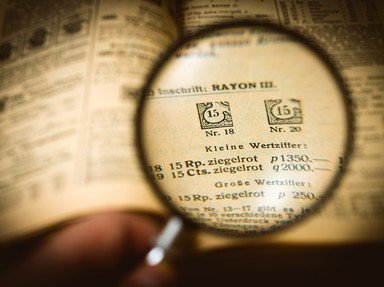Quiz Answer Key and Fun Facts
1. The crime scene suggests that one of the four knife throwers in the circus must be guilty, but they were all seen eating breakfast at the time of the murder. Sigmund begins his examination of the witnesses' subconscious ideas by asking a woman nearby him to sing a song that represents her role in the show. She sings: "He'd fly through air with the greatest of ease, the daring young man on the...". What completes this lyric?
2. Sigmund hears a chap talking in an Australian accent and asks him to describe his work. The man says, "I spend my days standing behind the rotating head of a row of funny men in Sideshow Alley while kids feed 'em ping pong balls. My game's called..." What words correctly complete his response?
3. A young boy wearing a clown costume is the next person under Sigmund's gaze. "Tell me son," says Sigmund, "describe the most important tool in your act." The boy replies, "Well sir, it's a vehicle with only one wheel. I guess you'd know it as a ..." Which of the following accurately completes his answer?
4. Sigmund sees an old man sitting away from the crowd and asks him to explain his role in the circus. The man says, "In the early twentieth century there were acts like mine in many a circus, but it has gone out of fashion. I ask spectators to look through Fresnel lenses to watch my tiny performers at work. My attraction is the..." How does he finish this statement?
5. Sigmund sees a woman treating blisters in her mouth and begins to question her. "Well, there is no real secret to this," she says, "You just have to tolerate pain if you want to work in the art of ..." What name does she provide for her talent?
6. Sigmund sees four clowns rehearsing their tumbles and stops to ask them whether it is true that, in the latter half of the twentieth century, Ringling Brothers ran a Clown College to train people in this art. What did the truthful clown tell him?
7. There is a small woman sunbaking on a safety net. Sigmund apologises for disturbing her and asks if this net is part of her act. She says, "Why, yes it is. In my act I am a projectile, and this net breaks my fall. I am a..." How does she describe herself?
8. Sigmund sees a man and a woman, apparently rehearsing their act, working together to make interesting shapes with their bodies. The woman turns to Sigmund and says, "I am the flier and Ralph here is the base. In our act we perform the Swizzle, the Flying Whale and the Reverse Candle. Our act is..." What title does she give their act?
9. A man carrying a large leather pouch walks by and Sigmund asks him to describe his work. "Well, I have had to learn to hyper-extend my neck and relax my upper oesophageal sphincter in order to perform my act. Put simply, I'm a..." What does he say he is?
10. Sigmund finds a woman cracking a whip loudly and asks her if it is part of her act. "Oh yes," she says, "but though the audience may think the whip is what keeps things under control, it's really just for show. The real stars of my show act on my hand and voice signals. I train..." What does she say she prepares for their performances?
11. Far away from the animal cages, Sigmund sees a group of acrobats and dancers rehearsing. He asks them what they do and a friendly man replies, "We are part of another circus, only here for a special double-header performance. We use our skills to deliver a show that tells a story, and we don't have any animals in our acts. Our circus is designed in the recent French tradition of ..." How does he finish this sentence?
12. A stern looking woman is standing outside a caravan containing several bears. Sigmund asks her if she is part of the circus' bear act and she replies in a thick Russian accent, "Da! I train ze bears to play hockey on ..." How does she finish this sentence to describe an act which is popular in Russian circus performances?
13. A young man is washing a small elephant with unusually large ears, and Sigmund wanders over towards them. "This is a handsome beast," Sigmund says, "What is his name?" The man replies, "He was named after a flying elephant in a Walt Disney animated classic. I'm sure you've guessed his name is..." What is the elephant's name?
14. Sigmund stops to buy a hot dog and asks the elderly vendor how he came to join the circus. "I fell in love with the idea when I was one of 1,400 people who appeared in a 1952 film directed by Cecil B. DeMille that was set in a circus. The film was 'The Greatest Show On...'." What is the last word in the film's title?
15. Sigmund sees an elderly woman smoking near a large tent. "Be careful," he warns her, "many people believe the massive Hartford circus fire of 1944 may well have been started by a carelessly dropped cigarette." She replies, "Oh, you mean 'the day the clowns cried'. It was a huge disaster." Which of the following statements could she truthfully tell Sigmund?
16. Sigmund sees a young man carrying a long pole and stops to ask him why he has it. The man replies: "It's a balancing pole and I use it in my act. My skill is funambulism, which you may know as..." How does the man finish his sentence?
17. Sigmund sees two acrobats using their legs to propel two other performers into the air, and is impressed to see the artists easily meeting feet to feet after the aerobatic tumbles are complete. Sigmund asks them about their act. He is told: "Our act is sometimes called human juggling, but its correct name derives from a character in Greek mythology who flew too close to the sun. His name was ..."
18. A man applying makeup calls Sigmund over and tells him: "Possibly no performers remind people of the circus more than those who practice my art, though popular culture sometimes portrays us in a negative light. Examples include Krusty from 'The Simpsons', Stephen King's Pennywise and Batman's arch enemy The Joker. I am a ..."
19. Overhead, Sigmund sees a woman sitting in something that looks like a hula hoop. "What's your act called?" he shouts up to her. What does she answer?
20. Sigmund sees a man wearing a safari suit, who is carrying a whip and a chair. As the man heads towards the animal cages Sigmund calls out: "Sir! What is your act?" What answer does the man provide?
21. Over near the popcorn stand Sigmund hears a man singing a very familiar tune that goes: 'doot-doot doodle-oodel-oot-doot doodet'. "Tell me my good man, by what name do you call that melody?" How does the man reply?
22. Sigmund looks inside a tent and sees a woman setting up what looks like an old-fashioned miniature circus. He asks the woman to point out her favourite part of the display and she picks out an ornately painted carriage. "This is how old-time circus folk used to get around," she explains, "it's a circus ..." How does she finish this sentence?
23. Sigmund sees a young man painting a gold bridle onto a wooden horse that seems to have been impaled on a pole. "That's some horse you have there," Sigmund remarks, "Tell me, what do you do in this circus?" What does the man reply?
24. Sigmund is passing the circus band and he stops to ask them to name their favourite song. The tuba player replies: "Well, let's see. I like the one about an elephant who 'packed her trunk and said goodbye to the circus'. It's got a ripping tuba part. The song's called...". How does he finish this statement?
25. Sigmund looks back over his notes and realises that, once again, his witnesses have revealed a subliminal message that will help him solve the crime. Take the first letter of the correct answers to questions 1-24 of this quiz (in order) to find the clue which has helped Sigmund solve the crime. He realises that one of his four suspects is guilty because their alibi can be disputed. Which knife thrower does he accuse?
Source: Author
looney_tunes
This quiz was reviewed by FunTrivia editor
Pagiedamon before going online.
Any errors found in FunTrivia content are routinely corrected through our feedback system.

